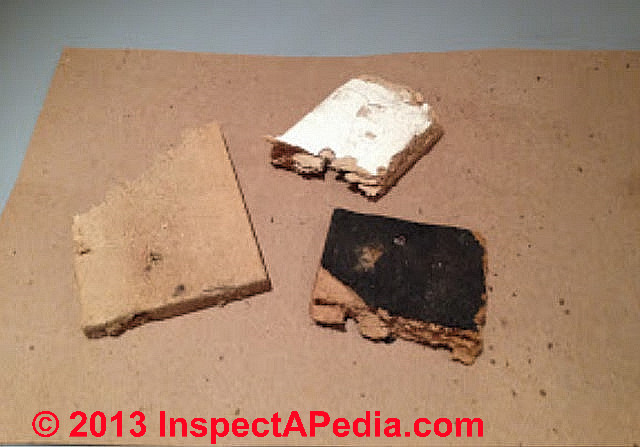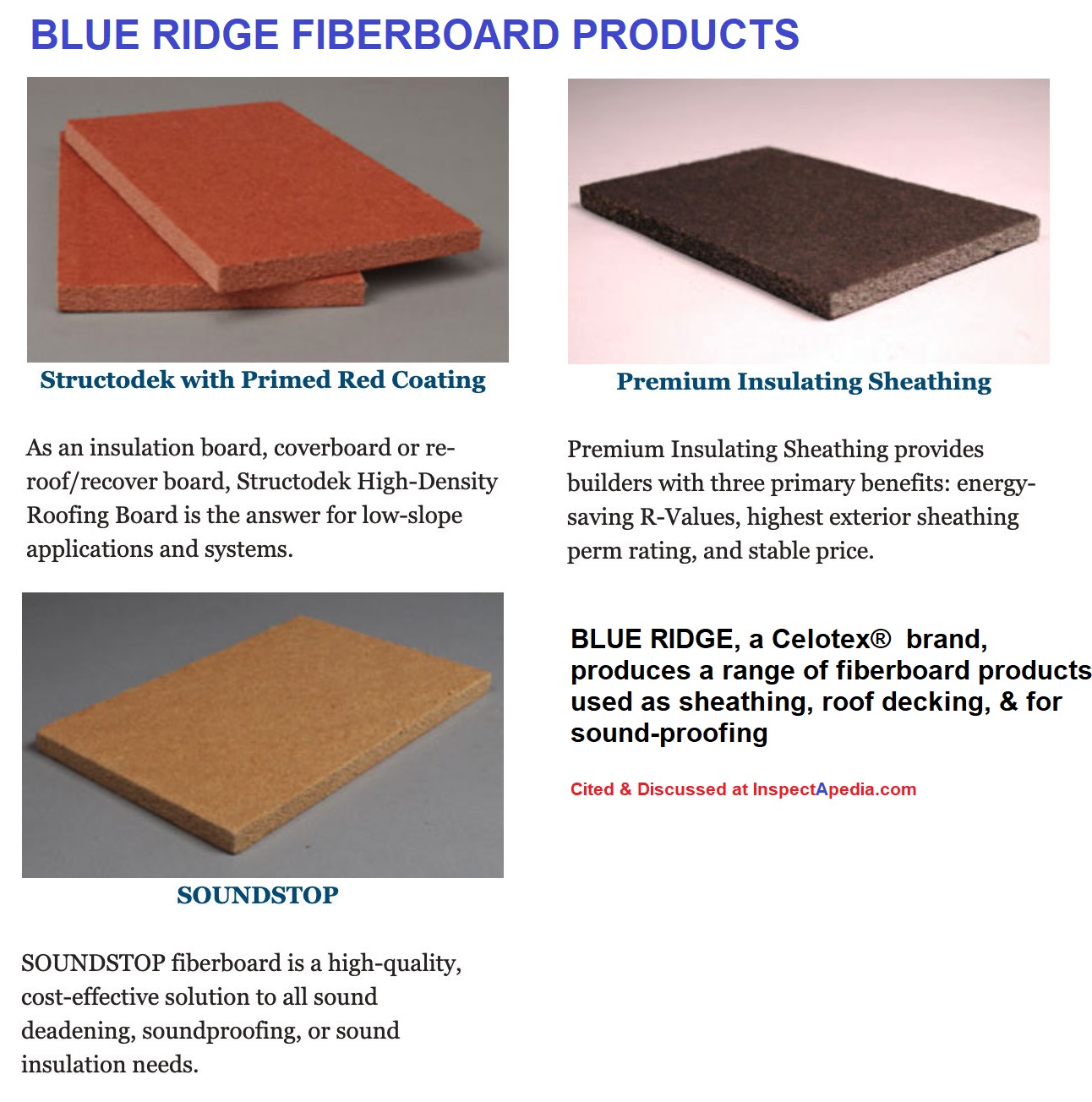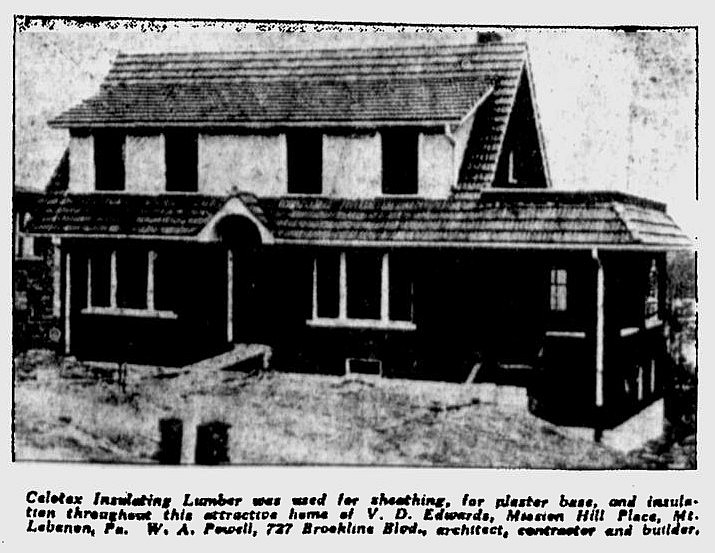 Asbestos in Celotex Sheathing & Insulating Board
Asbestos in Celotex Sheathing & Insulating Board
Properties of Celotex Insulating Lumber & Celotex Blue Ridge Fiberboard
- POST a QUESTION or COMMENT about fiberboard building sheathing: how to identify fiberboard products, fiberboard uses, fiberboard, Celotex, Homasote, Insulite & other brands, fiberboard ingredients, does fiberboard contain asbestos?
Asbestos content of Celotex building roof & wall sheathing products. Does or did Celotex® fiberboard and insulating board products contain asbestos?
This article addresses worries about asbestos in Celotex brand building sheathing products - a question that comes up during building demolition and renovation.
The short answer is "no" for wood-based or plant-based products and "yes" for certain other (not plant-based) LDB or LDF products specifically described as asbestos board; the history is interesting. We include research citations and testing lab referrals for concerned readers.
This article series describes and provides photographs that aid in identifying various insulating board & fiberboard sheathing materials used on building walls and roofs, such as Homasote, Celotex, Insulite, and Masonite insulating board sheathing products.
InspectAPedia tolerates no conflicts of interest. We have no relationship with advertisers, products, or services discussed at this website.
- Daniel Friedman, Publisher/Editor/Author - See WHO ARE WE?
What is Celotex Insulating Lumber? Do insulating board products contain asbestos?
Reader Question: asbestos in Celotex Insulating Lumber?
I have a home built in 1940 that used a brown fiber board called "Celotex Insulating Lumber" looks like is was designed to be used as sheathing and lath.
Made in either Chicago on Louisiana. Anyone familiar with this? Or know if it contained asbestos? - Dan Theisen 1/30/12
Reply:
Dan, Celotex, a Chicago company, has been a producer of a wide variety of insulating sheathing boards for a long time and the company continues to produce modern insulating board products as well.
Celotex Insulating Lumber was introduced by the Celotex corporation in 1922, making it
"... possible for the first time to build a completely insulated house practically without extra cost". [8]
Our illustration (left) shows Celotex insulating lumber on the exterior of a Lebanon PA home.
There was some question, not substantiated by any research I could find, that because some wood fiber board products may have been made at the same site where asbestos-containing materials had been used, that there may have been some cross contamination; that theory has not been supported by research articles that I've found nor by lab tests yet provided to us.
See details at CELOTEX ASBESTOS PRODUCTS
where we state, in describing Celotex fiberboard:
Celotex™ Cane fiber products [Cane products were not themselves an asbestos-containing product, though some may have been manufactured at facilities where asbestos was present - Ed.]
The company described their Cemesto exterior sheathing as
"... cane fiber insuation, coated on both sides with asphalt, with a weatherproof surface of crushed mineral granules in colors ..."
But we note that there is understandable confusion about this question since other sources note
Carey Asbestos Mine Celotex Products: Other Building insulation products including products directly associated with the Celotex-owned Carey Asbestos mine in Canada and containing asbestos include the following:
- Carey Cemesto board [appears in some citations as"Carey Cenesto board"]
In an abundance of caution, you would treat a mineral-granule-coated Cemesto board (cane fiber board), an exterior sheathing, as possibly containing asbestos; you would not expect to find this material inside of a building such as on an interior wall or ceiling.
Checks & MSDS Citations for Asbestos Content in Celotex Fiberboard Insulation
A review of the patents and product description for Celotex insulating lumber products shows that asbestos was not among the product's listed ingredients.
See IDENTIFY Celotex® INSULATING BOARD & FIBERBOARD PRODUCTS
For more about Celotex sheathing and products
see CELOTEX HISTORY & PRODUCTS.
Also see FIBERBOARD SHEATHING INGREDIENTS and also
see FIBERBOARD SHEATHING MSDS for details about the ingredients or constituents of fiberboard sheathing products. They vary but they're basically cellulose, bonder, and waterproofing.
In "Insulite Co. vs. Reserve Supply Co", a 1932 lawsuit, relevant patents and ingredients are described, including a composition of plaster of paris, cement, or other like substance, combined with hair, wood fiber, sawdust, wool, wood shavings, excelsior, straw, or similar substances. (Asbestos was not cited in the product description. )[11]
Watch out: ** Wood dust is listed by the IARC as a human carcinogen (Group 1).
In other words, the dose makes the poison for all substances.
Really?: we have read a few accounts indicating that while asbestos was not an ingredient in fiberboard insulating sheet products, some of these products may have been manufactured at or near facilities previously used to process asbestos materials.
The question of cross-contamination arose but I have not yet found a report of actual asbestos contamination in fiberboard from that source (nor others).
Also see
CELOTEX ASBESTOS PRODUCTS where we discuss the asbestos question in Celotex products.
Celotex Blue Ridge Fiberboard Sheathing Products & Properties
 Blue Ridge fiberboard is a Celotex® brand of fiberboard products.
Blue Ridge fiberboard is a Celotex® brand of fiberboard products.
These are insulating board products made of "cellulosic fiber" described more familiarly as fiberboard sheathing.
The product line is described by the company as:
Under the BLUE RIDGE FIBERBOARD, Inc. banner, Celotex® products such as Structodek® roofing insulation board, SoundStop® fiberboard panels, and Premium Insulating Sheathing will continue to offer building professionals the same uncompromising performance they have depended on in the past.
BLUE RIDGE FIBERBOARD has the largest available selection of fiberboard products, serving manufacturers of bulletin boards, dry mark and magnetic boards, office partitions, laminated furniture and packaging.
It is the mission of BLUE RIDGE FIBERBOARD to not only offer a superior product at a reasonable price but to continue the past tradition of reliability into the low-slope roofing market.
In addition to being nationally available, BLUE RIDGE FIBERBOARD fiberboard products are earth-friendly, contributing toward the vast criteria set for green building.
BLUE RIDGE FIBERBOARD products are manufactured using wood fibers using an environmentally friendly process. - retrieved 2021/05/27 original source: https://www.blueridgefiberboard.com/about/
- Contact: Blue Ridge Fiberboard, Danville Plant
Website: https://www.blueridgefiberboard.com/ Tel: WEST COAST: 800-535-4088
EAST COAST: 800-233-8721 Technical Support Tel: 800-596-9699
Danville Plant 250 Celotex Dr. Danville, VA 24541 USA - the company has offices and ware houses across the U.S. with its principal manufacturing facility in Danville, VA. The properties of the three BlueRidge fiberboard products and the application of these fiberboards are given in brochures provided by the company. - Blue Ridge STRUTODEK ROOFING BOARD DATA SHEET [PDF] (2019) Celotex/BlueRidge, retrieved 2021/05/27 original source https://www.blueridgefiberboard.com/
Excerpt: The proprietary, patented, non-asphaltic Primed Red Coating integrated on the surface of STRUCTODEK HD possesses unique bonding characteristics that ultimately result in superior adhesion capabilities with the current membrane & adhesive technology on the market today.
The nonasphaltic Primed Red Coating is compatible with all single-ply membranes including PVC, TPO, EPDM, and CSPE without concern of premature membrane degradation that is often associated with asphalt emulsion coated berboard products. Additionally the Primed Red Coating, unlike asphalt emulsion coated products, has proven to be compatible with traditional, low VOC and water-based adhesives as well as many foam adhesives. - Blue Ridge SOUNDSTOP INSULATING BOARD DATA SHEET [PDF] (2021) Op. Cit.
Excerpt:
SOUNDSTOP must always be installed behind gypsum drywall in interior wall and ceiling applications, or between two layers of sub oor in oor applications. Install SOUNDSTOP vertically to wall framing with a 1/8” (3.2 mm) gap between adjoining sheets; at wall, oor and ceiling junctures; and around door and window openings.
After application of SOUNDSTOP panels, it is recommended that the drywall is applied as soon as practical.
- Blue Ridge SOUNDSTOP INSULATING BOARD INSTALLATION GUIDE [PDF] for walls & ceilings, Celotex/BlueRidge, retrieved 2021/05/27 original source https://www.blueridgefiberboard.com/
- Blue Ridge INSULATING SHEATHING BROCHURE [PDF]
- Blue Ridge INSULATING SHEATHING SPECIFICATIONS [PDF] Regular Fiberboard Sheathing (2021)
Excerpts:
Specifier Notes: This guide specification is written according to the Construction Specifications Institute (CSI) MasterFormat 2020. The section must be carefully reviewed and edited by the architect or engineer to meet the requirements of the project. Coordinate this section with other specification sections and the drawings.
Specifier Notes: PREMIUM INSULATING SHEATHING is an exterior fiberboard wall sheathing panel comprised of interlaced wood fibers and vegetable starch binder; eliminating the need for formaldehyde based adhesives, thus providing a remarkably green product. It is easy to install and cuts with a knife, saving time and money. Premium Insulating Sheathing saves energy costs at a low cost per R-value.
Premium Insulating Sheathing provides an R-value of 1.3 per ½” (13 mm), which is more than double the R-value of OSB and gypsum sheathing. Premium Insulating Sheathing’s high vapor permeance allows the wall to “breathe”, permitting moisture to escape and reducing the threat of mold growth.
PREMIUM INSULATING SHEATHING can be used in those exterior wall sheathing applications where code provides other means of structural bracing, as noted in IRC Table 602.10.4 Bracing Methods, and IBC Table 2308.6.3(1). Code compliant wall bracing solutions may require review by a design professional, and require local building official approval.
Refer to local building codes and building official for specific requirements.
PREMIUM INSULATING SHEATHING is offered in coated one side (C1S) and integral coated six sides (C6S) configurations. Both coating configurations are manufactured to conform with the same physical property specification requirements of ASTM C208, Type IV, Grade 1 Regular Wall Sheathing
- REFERENCES
- ASTM C208 - Standard Specifications for Cellulosic Fiber Insulating Board. Type IV – Wall Sheathing, Grade 1 - Regular
- ASTM C209 - Standard Test Methods for Cellulosic Fiber Insulating Board.
- ASTM C846 – Application of Cellulosic Fiber Insulating Board for Wall Sheathing.
- ASTM D1554 – Definitions of terms Relating to Wood Based Fiber and Particle Panel Materials.
- ANSI/AHA – A194.1 Cellulosic Fiberboard.
- U. S. Department of Commerce: PS57-73, Cellulosic Fiber Insulating Board.
Research on Asbestos in Celotex Products
- Agnew, Harvey, The REDUCTION of NOISE in HOSPITALS [PDF] Hospital Service Department Notes, Can Med Assoc J. 1930 Mar; 22(3): 414–418.
Excerpts: Sounds transmitted through ventilators may be reduced by covering the openings into the rooms with a "baffle", lined with good sound absorbing material such as acousti-celotex.
The organic acoustical products are made of fibre, felt, and other organic material.
One of the best of these, "Acousti-Celotex," is widely used in hospitals and broadcasting stations and comes as a perforated fibre tile made of compressed sugar cane. (Fig.. 2).
In the 11/4 inch thickness, the coefficient-of absorption is 70 per cent; the 3/4 inch thickness has a value of 47 per cent. (Thinner sheets of this product are used under linoleum and carpet.)
Another is "Nashkote A," a hair-and asbestos felt covered with muslin, with a one-inch felt; this has a coefficient of 45 per cent. "Nashkote B," which is covered with white oilcloth with pinhole perforations, has a coefficient of 64 per cent. As the method of determining coefficients varies in different laboratories, these percentages must be regarded as representing approximate relative values only.
Other materials used in making these coverings are wood fibre, asbestos, and flax.
Porous products, especially when organic, might be considered as likely breeding places for vermin. However, Neergaard comments upon this possibility in his studies and finds no report of such occurrence where modern methods of sound deadening have been used.
...
Acoustic-celotex has a soft fibrous surface which cannot be washed, but which, F. R. Watson has demonstrated, can be painted without diminution of absorbent power, provided the holes are not filled.
If soaked with water, it dries slowly with some danger of loosening.
Nashkote B is more readily washed, having an oilcloth surface; it retains water longer when soaked, which may affect the cement bindeing it to the ceiling. Its replacement cost of is low. - Aghimien, Douglas Omoregie, and Ayodeji Emmanuel Oke. APPLICATION OF VALUE MANAGEMENT TO SELECTED CONSTRUCTION PROJECTS IN NIGERIA [PDF] Developing Country Studies 5, no. 17 (2015): 8-14.
Excerpt: Asbestos board, celotex ceiling board, PVC ceiling sheet and plywood ceiling board as ceiling finishes were suggested ...
Really? this citation is included as an example of how the close proximity of the word "asbestos" to "Celotex" in literature searches can be mis-leading. Nothing in that spedific entence cites asbestos in the Celotex ceiling board. - Bozsaky, David. NATURE-BASED THERMAL INSULATION MATERIALS FROM RENEWABLE RESOURCES–A STATE-OF-THE-ART REVIEW [PDF] Slovak Journal of Civil Engineering 27, no. 1 (2019): 52-59.
Excerpt:
In order to protect reed products from insects, mold and fire, insulating plates with a two-sided asbestos covering (Celotex) were developed in the 1920s (Bynum, 2001; Déry, 2010; Manohar et al., 2006) - Bozsaky p. 55. - Ringel, A. S. "Sound-proofing and acoustic treatment of RKO stages." Journal of the Society of Motion Picture Engineers 15, no. 3 (1930): 352-369.
Excerpt: in the sound-proofing ; the layers of Celotex and rock wool provide the acoustic damping. … asbestos board on the inside. [Note: text is discontiuous so this citation is uncertain - Ed.] - Schonfeld, Simcha David. "Establishing the Casual Link in Asbestos Litigation: An Alternative Approach." Brook. L. Rev. 68 (2002): 379.
Excerpt:
… demonstrates numerous inherent differences between DES and asbestos,"75 including the great variance of dangers among asbestos products noted in Celotex.™
...
Continue reading at CELOTEX HISTORY & PRODUCTS or select a topic from the closely-related articles below, or see the complete ARTICLE INDEX.
Or see these
Recommended Articles
- ASBESTOS IDENTIFICATION IN BUILDINGS - home
- ASBESTOS TESTING LAB LIST
- ASBESTOS TESTING SAMPLE COLLECTION
- FIBERBOARD SHEATHING - home
- CANEBOARD PANELS
- CARDBOARD CORRUGATED FIBERBOARD
- CELOTEX HISTORY & PRODUCTS
- DEFINITION of FIBERBOARD SHEATHING
- HISTORY of FIBERBOARD INSULATING SHEATHING
- HOMASOTE HISTORY & PRODUCTS
- SYNONYMS for FIBERBOARD SHEATHING
- FIBERBOARD CEILING & WALL COVERINGS
- FIBERBOARD MANUFACTURERS & BRAND NAMES
- FIBERBOARD PANEL REPAIR
- FIBERBOARD PLASTER BASE SYSTEMS
- FIBERBOARD ROOF SHEATHING
- FIBERBOARD SHEATHED WALL BRACING
- FIBERBOARD SHEATHING ASBESTOS CONTENT
- FIBERBOARD SHEATHING INGREDIENTS
- FIBERBOARD SHEATHING FIRE RATINGS
- FIBERBOARD SHEATHING IDENTIFICATION
- FIBERBOARD SHEATHING INSECT DAMAGE
- FIBERBOARD SHEATHING MOLD CONTAMINATION
- FIBERBOARD SHEATHING MSDS
- FIBERBOARD ROOFING & FIBER-WOOD ROOFING
- FIBERBOARD PROTECT from WATER
- FIBERBOARD SOUND INSULATION
- SHEATHING, FIBERBOARD ASBESTOS CONTENT
- SHEATHING FIBERBOARD CONSTRUCTION
- SIDING HARDBOARD IDENTIFICATION & CLAIMS
- HARDBOARD MASONITE™ & OTHER BRANDS
- HARDBOARD Masonite™-like INGREDIENTS
- SHEATHING, EXTERIOR PRODUCT INDEX
Suggested citation for this web page
CELOTEX INSULATING BOARD ASBESTOS CONTENT at InspectApedia.com - online encyclopedia of building & environmental inspection, testing, diagnosis, repair, & problem prevention advice.
Or see this
INDEX to RELATED ARTICLES: ARTICLE INDEX to ASBESTOS HAZARDS
Or use the SEARCH BOX found below to Ask a Question or Search InspectApedia
Ask a Question or Search InspectApedia
Try the search box just below, or if you prefer, post a question or comment in the Comments box below and we will respond promptly.
Search the InspectApedia website
Note: appearance of your Comment below may be delayed: if your comment contains an image, photograph, web link, or text that looks to the software as if it might be a web link, your posting will appear after it has been approved by a moderator. Apologies for the delay.
Only one image can be added per comment but you can post as many comments, and therefore images, as you like.
You will not receive a notification when a response to your question has been posted.
Please bookmark this page to make it easy for you to check back for our response.
IF above you see "Comment Form is loading comments..." then COMMENT BOX - countable.ca / bawkbox.com IS NOT WORKING.
In any case you are welcome to send an email directly to us at InspectApedia.com at editor@inspectApedia.com
We'll reply to you directly. Please help us help you by noting, in your email, the URL of the InspectApedia page where you wanted to comment.
Citations & References
In addition to any citations in the article above, a full list is available on request.
- R-Value of Wood, U.S. Department of Energy
- In addition to citations & references found in this article, see the research citations given at the end of the related articles found at our suggested
CONTINUE READING or RECOMMENDED ARTICLES.
- Carson, Dunlop & Associates Ltd., 120 Carlton Street Suite 407, Toronto ON M5A 4K2. Tel: (416) 964-9415 1-800-268-7070 Email: info@carsondunlop.com. Alan Carson is a past president of ASHI, the American Society of Home Inspectors.
Thanks to Alan Carson and Bob Dunlop, for permission for InspectAPedia to use text excerpts from The HOME REFERENCE BOOK - the Encyclopedia of Homes and to use illustrations from The ILLUSTRATED HOME .
Carson Dunlop Associates provides extensive home inspection education and report writing material. In gratitude we provide links to tsome Carson Dunlop Associates products and services.



